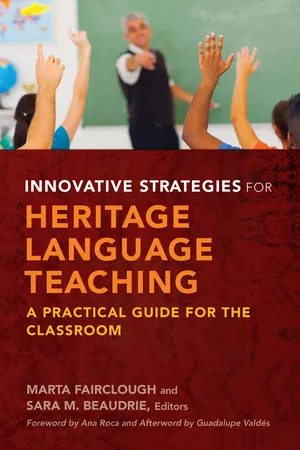1
Toward a Prototype Model of the Heritage Language Learner
Understanding Strengths and Needs
EVE ZYZIK
UNIVERSITY OF CALIFORNIA, SANTA CRUZ
The difficulty of defining and characterizing the heritage speaker has been duly acknowledged in a wide range of scholarly publications with both theoretical and pedagogical motivations. This problem of definition is not unique to the heritage language (HL) context. In similar fashion, there continues to be debate about the criteria for defining the native speaker, with questions centering on whether a categorical distinction between the native speaker and the native user can be upheld (see Davies 2013). Establishing the criteria for group membership (e.g., being a native speaker of language X) is inherently problematic when there is variability within the group. Although we might be tempted to think of native speakers as constituting a homogeneous group—that is, as having the same mental grammar—research has begun to emphasize important differences among native speakers stemming from levels of formal education (see Dąbrowska 2012). In the HL bilingual context, the variability within the group is far greater than among monolingual native speakers (de Swart 2013; Rothman and Treffers-Daller 2014).
The goal of this chapter is to move beyond definitions in order to better understand the varied population of heritage speakers who, in the academic context, become HL learners. Traditionally, this variability has been presented on a bilingual continuum: monolinguals of language A and language B represent the two extremes, and HL learners are situated somewhere in between, depending on their relative strength (i.e., dominance) in both languages (Valdés 2001, 2005). An alternative way of understanding the diversity of HL learners is to situate the HL learner in a category that exhibits prototype effects. This view of categorization is well known in cognitive psychology (e.g., Rosch 1975) and is a fundamental tenet in cognitive linguistics (e.g., Taylor 2003). In the prototype model of categorization, a given category can have fuzzy boundaries and be internally graded, meaning that some members are more typical or central to the category than others. For example, it has been shown that “chair” and “sofa” are better representatives of the category “furniture” than are “telephone” or “lamp.” Instead of defining a concept based on a set of discrete and necessary features, category membership is determined by approximation to the prototype. In the realm of linguistic description, Taylor (2015) suggests that the prototype model could be applied to elusive notions such as “native speaker” and “bilingual speaker.” In fact, Escudero and Sharwood Smith (2001) developed a preliminary definition of “native speaker” along these lines by considering both prototypical and peripheral features. The prototype model holds promise for understanding the notion of HL learner as well. In such a model we dispense with comparing the HL learner to the monolingual speaker or to the second language (L2) learner; instead the HL learner is understood in relation to a central member of the category.
In constructing the prototype, a logical starting point is to examine the various attributes that have been proposed in existing definitions. My review of existing definitions in oft-cited publications, both classic and more recent (e.g., Benmamoun, Montrul, and Polinsky 2013; Polinsky 2015; Polinsky and Kagan 2007; Rothman and Treffers-Daller 2014; Valdés 2001; Van Deusen-Scholl 2003), reveals the following recurring attributes of HL learners:
• Early exposure to the heritage language in the home
• Proficiency in the heritage language
• Bilingual to some degree
• Dominant in a language other than the heritage language
• Ethnic/cultural connection to the heritage language
Among the aforementioned attributes, proficiency is particularly salient: it has been emphasized in all narrow definitions, thus excluding learners with a “heritage motivation” (Van Deusen-Scholl 2003, 222) but no functional ability in the language. Nevertheless, proficiency is by itself a poor predictor of group membership; there are many proficient speakers of a language who are not HL learners. In fact, L2 learners can match or surpass HL learners on standardized measures of proficiency (see discussion below). Thus, we need an attribute that can serve to differentiate HL learners from other types of proficient speakers. In this chapter, I outline a prototype model of the HL learner that includes the attribute of implicit knowledge. Implicit knowledge has received relatively little attention in the field of HL pedagogy but has become increasingly important in experimental research (e.g., Montrul et al. 2014). Understanding the HL learner from the perspective of implicit knowledge can also clarify why certain pedagogical methods and materials originally designed for the L2 classroom may not be easily transferable to the HL context.
Core Issues: Proficiency and Implicit Knowledge
Proficiency
Proficiency has figured prominently in descriptions of HL learners although the construct has been vaguely defined or simply assumed. Wu and Ortega (2013) explain that proficiency can be defined either broadly or narrowly. In the realm of standardized testing such as the ACTFL oral proficiency interview (OPI), proficiency is understood broadly as functional language ability, or “what individuals can do with language in terms of speaking, writing, listening, and reading in real-world situations in a spontaneous and non-rehearsed context” (ACTFL 2012, 3). In contrast, in research on L2 and HL acquisition, proficiency is g...
